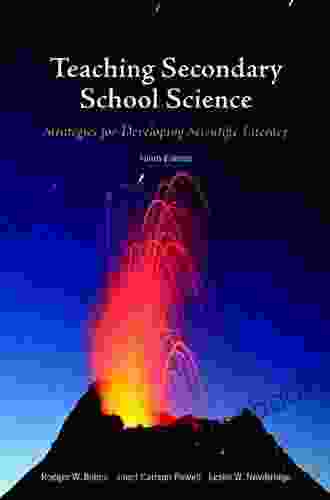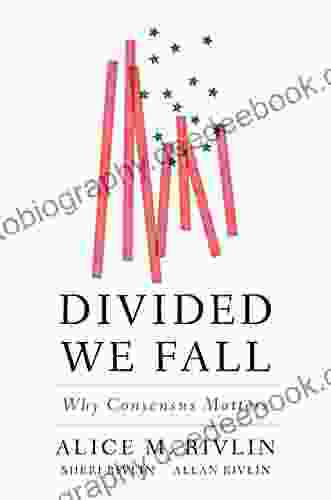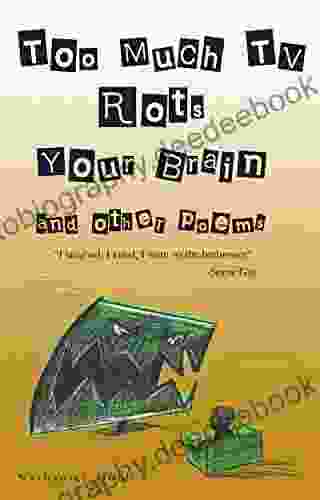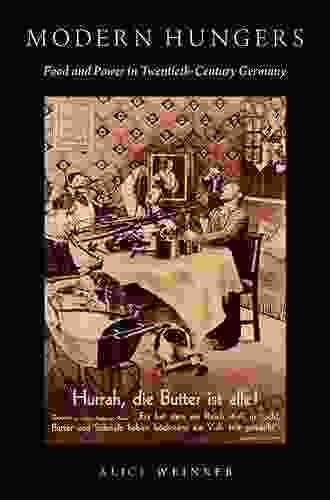Strategies For Developing Scientific Literacy

Scientific literacy is the ability to understand and engage with science and technology. It is a critical skill for citizens in the 21st century, as science and technology play an increasingly important role in our lives. Scientific literacy allows us to make informed decisions about our health, our environment, and our future.
There are many different strategies that can be used to develop scientific literacy. Some of the most effective strategies include:
4.4 out of 5
| Language | : | English |
| File size | : | 2153 KB |
| Text-to-Speech | : | Enabled |
| Screen Reader | : | Supported |
| Enhanced typesetting | : | Enabled |
| Word Wise | : | Enabled |
| Print length | : | 356 pages |
- Teaching science in a way that is relevant to students' lives. When students can see how science is connected to their own experiences, they are more likely to be interested in learning it.
- Promoting scientific inquiry. Scientific inquiry is the process of asking questions, making observations, and testing hypotheses. It is a fundamental part of science, and it helps students to develop critical thinking skills.
- Fostering a culture of science in the classroom and beyond. A culture of science is one in which science is valued and respected. It is a place where students feel comfortable asking questions, sharing ideas, and taking risks.
By implementing these strategies, we can help to develop a scientifically literate citizenry that is prepared to meet the challenges of the 21st century.
Teaching Science in a Way That Is Relevant to Students' Lives
One of the most important things that we can do to develop scientific literacy is to teach science in a way that is relevant to students' lives. When students can see how science is connected to their own experiences, they are more likely to be interested in learning it.
There are many different ways to make science relevant to students' lives. One way is to use real-world examples. For example, when teaching about the solar system, you could talk about the recent landing of the Perseverance rover on Mars. Or, when teaching about the human body, you could talk about the importance of exercise and nutrition.
Another way to make science relevant to students' lives is to let them do hands-on activities. Hands-on activities allow students to experience science firsthand, and they can help to make learning more memorable. For example, when teaching about the properties of matter, you could have students conduct an experiment to see how different materials react to heat.
Promoting Scientific Inquiry
Scientific inquiry is the process of asking questions, making observations, and testing hypotheses. It is a fundamental part of science, and it helps students to develop critical thinking skills.
There are many different ways to promote scientific inquiry in the classroom. One way is to give students opportunities to ask questions. Another way is to provide students with opportunities to make observations. And finally, you can provide students with opportunities to test hypotheses.
When students are given opportunities to ask questions, they are more likely to develop a sense of curiosity and wonder about the world around them. They are also more likely to become independent learners.
When students are given opportunities to make observations, they are more likely to develop their observational skills. They are also more likely to become more aware of their surroundings.
When students are given opportunities to test hypotheses, they are more likely to develop their critical thinking skills. They are also more likely to become more confident in their ability to solve problems.
Fostering a Culture of Science in the Classroom and Beyond
A culture of science is one in which science is valued and respected. It is a place where students feel comfortable asking questions, sharing ideas, and taking risks.
There are many different ways to foster a culture of science in the classroom. One way is to create a safe and supportive learning environment. Another way is to encourage students to ask questions and share their ideas. And finally, you can provide students with opportunities to take risks.
When students feel safe and supported, they are more likely to take risks and try new things. They are also more likely to ask questions and share their ideas.
When students are encouraged to ask questions and share their ideas, they are more likely to develop a sense of community and belonging. They are also more likely to become independent learners.
When students are given opportunities to take risks, they are more likely to develop their creativity and innovation. They are also more likely to become more confident in their ability to solve problems.
By implementing these strategies, we can help to develop a scientifically literate citizenry that is prepared to meet the challenges of the 21st century.
Scientific literacy is essential for citizens in the 21st century. It allows us to make informed decisions about our health, our environment, and our future. There are many different strategies that can be used to develop scientific literacy, including teaching science in a way that is relevant to students' lives, promoting scientific inquiry, and fostering a culture of science in the classroom and beyond. By implementing these strategies, we can help to ensure that our students are prepared to meet the challenges of the 21st century.
4.4 out of 5
| Language | : | English |
| File size | : | 2153 KB |
| Text-to-Speech | : | Enabled |
| Screen Reader | : | Supported |
| Enhanced typesetting | : | Enabled |
| Word Wise | : | Enabled |
| Print length | : | 356 pages |
Do you want to contribute by writing guest posts on this blog?
Please contact us and send us a resume of previous articles that you have written.
 Book
Book Novel
Novel Page
Page Chapter
Chapter Text
Text Genre
Genre Paperback
Paperback E-book
E-book Magazine
Magazine Paragraph
Paragraph Sentence
Sentence Shelf
Shelf Glossary
Glossary Bibliography
Bibliography Foreword
Foreword Preface
Preface Synopsis
Synopsis Footnote
Footnote Codex
Codex Tome
Tome Library card
Library card Biography
Biography Autobiography
Autobiography Reference
Reference Encyclopedia
Encyclopedia Librarian
Librarian Catalog
Catalog Card Catalog
Card Catalog Archives
Archives Periodicals
Periodicals Study
Study Research
Research Lending
Lending Academic
Academic Reading Room
Reading Room Rare Books
Rare Books Special Collections
Special Collections Study Group
Study Group Book Club
Book Club Textbooks
Textbooks Phil Race
Phil Race Iain Galbraith
Iain Galbraith Jyssica Schwartz
Jyssica Schwartz Susan Ware
Susan Ware Sue Orr
Sue Orr Scott Kashman
Scott Kashman Alice Hunter
Alice Hunter Matt Pike
Matt Pike Melissa Margaret Schneider
Melissa Margaret Schneider William C Johnson
William C Johnson Jules Bennett
Jules Bennett Selena
Selena Craig Unger
Craig Unger Ava Armstrong
Ava Armstrong Amanda Stanton
Amanda Stanton Richard North Patterson
Richard North Patterson Isabella Thorne
Isabella Thorne Sona Bhatnagar
Sona Bhatnagar Joice Berth
Joice Berth Gerry Langeler
Gerry Langeler
Light bulbAdvertise smarter! Our strategic ad space ensures maximum exposure. Reserve your spot today!
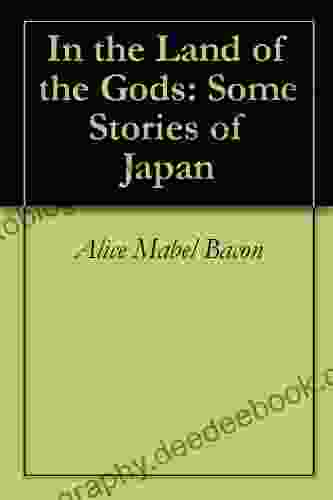
 George BellUnveiling the Enchanting Tales of Japan: A Literary Journey Through Time and...
George BellUnveiling the Enchanting Tales of Japan: A Literary Journey Through Time and...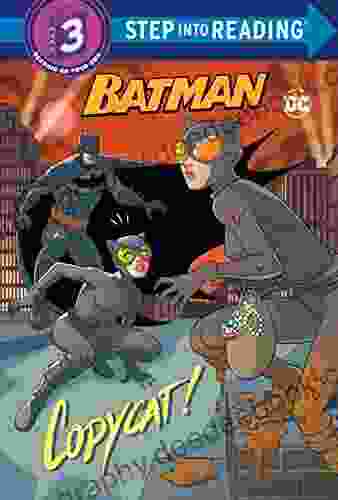
 Devon MitchellUnveiling the Fascinating World of Copycat DC Super Heroes: Batman Steps into...
Devon MitchellUnveiling the Fascinating World of Copycat DC Super Heroes: Batman Steps into... Carl WalkerFollow ·6.1k
Carl WalkerFollow ·6.1k Ken SimmonsFollow ·11.2k
Ken SimmonsFollow ·11.2k Stephen FosterFollow ·19.1k
Stephen FosterFollow ·19.1k Marcel ProustFollow ·9.2k
Marcel ProustFollow ·9.2k Dennis HayesFollow ·9.4k
Dennis HayesFollow ·9.4k Ashton ReedFollow ·3k
Ashton ReedFollow ·3k John MiltonFollow ·12.3k
John MiltonFollow ·12.3k Javier BellFollow ·10.2k
Javier BellFollow ·10.2k

 Fletcher Mitchell
Fletcher MitchellEducation And Peace Montessori 10: Where Learning...
A Symphony of Learning and Well-being Amidst...

 Glen Powell
Glen PowellUnveiling the Wonders of Language and Literacy...
Language and literacy...

 Rod Ward
Rod WardThe Portable Benjamin Franklin: A Timeless Collection of...
In the vast tapestry of American history,...

 Kelly Blair
Kelly BlairDemocracy Versus Authoritarianism in the Post-Pandemic...
The COVID-19...

 Colin Richardson
Colin RichardsonGet Inspired To Shoot Over 130 Poses
Are you looking for...
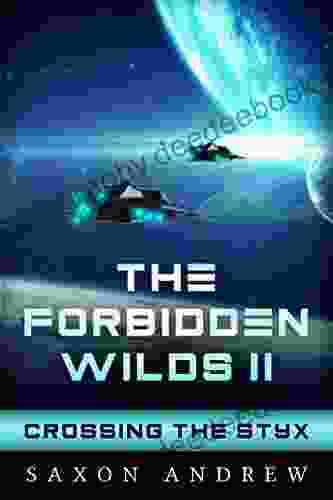
 Jared Nelson
Jared NelsonEmbark on a Shadowy Journey: The Forbidden Wilds and...
Prologue: A Realm Enshrouded in Darkness As...
4.4 out of 5
| Language | : | English |
| File size | : | 2153 KB |
| Text-to-Speech | : | Enabled |
| Screen Reader | : | Supported |
| Enhanced typesetting | : | Enabled |
| Word Wise | : | Enabled |
| Print length | : | 356 pages |


